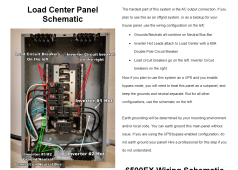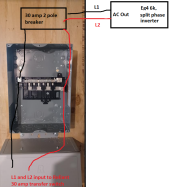lboucher26
New Member
- Joined
- Sep 24, 2022
- Messages
- 59
Hi All
Done DIY home electrical for many years, but this is my first time doing solar.
I'm putting in a Eg4 6k.
I have a Transfer Switch i intend to use to for some loads.
In between the Eg4 output and the Transfer Switch input, i plan to have QOC16UF load center.
My question is, it it Kosher to wire from the EG4, into 1 of the breakers (30 amp). Then go from the main lug terminals down to the input of the transfer switch?
I'm just not used to wiring incoming power direct to a breaker... And i am not used to wiring an output from the main terminals...
But technically, all the wiring would be protected by the 1 breaker... Other breakers/wires past those breakers would be sized appropriately.
See attached image.
Side question
If i use 30 amp breaker. Will the breaker ever actually trip or would the Inverter shut down prior? Yes i will be putting in a breaker regardless. Just asking.
Thank you
Done DIY home electrical for many years, but this is my first time doing solar.
I'm putting in a Eg4 6k.
I have a Transfer Switch i intend to use to for some loads.
In between the Eg4 output and the Transfer Switch input, i plan to have QOC16UF load center.
My question is, it it Kosher to wire from the EG4, into 1 of the breakers (30 amp). Then go from the main lug terminals down to the input of the transfer switch?
I'm just not used to wiring incoming power direct to a breaker... And i am not used to wiring an output from the main terminals...
But technically, all the wiring would be protected by the 1 breaker... Other breakers/wires past those breakers would be sized appropriately.
See attached image.
Side question
If i use 30 amp breaker. Will the breaker ever actually trip or would the Inverter shut down prior? Yes i will be putting in a breaker regardless. Just asking.
Thank you







